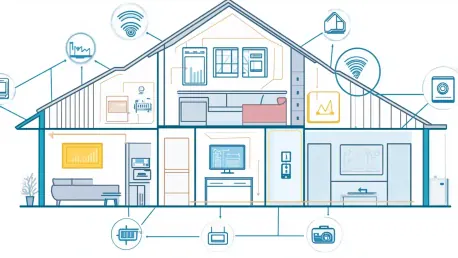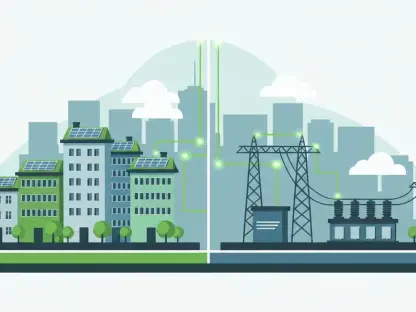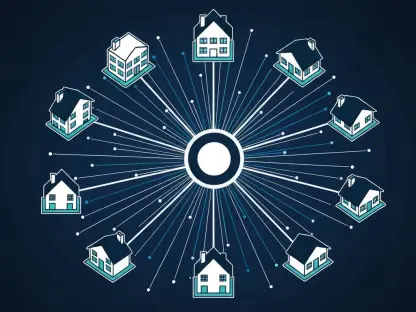The rapid proliferation of IoT devices within smart buildings brings with it the challenge of finding efficient, flexible, and maintenance-free power solutions. Traditional power sources, such as batteries and wired connections, pose limitations in terms of cost, flexibility, and sustainability. As the number of interconnected devices grows, innovative energy solutions become paramount. One such groundbreaking innovation is RF energy harvesting, which offers a compelling solution to the power conundrum facing next-generation smart building technology.
Harnessing RF Energy: A Promising Power Solution
Ambient RF vs. Controlled RF
RF energy harvesting involves capturing and converting radio frequencies (RF) into electricity, thus enabling IoT devices to operate without batteries or wired power. There are two primary methods of RF energy delivery: Ambient RF and Controlled RF. Ambient RF harvesting utilizes existing electromagnetic waves from sources such as Wi-Fi routers, mobile phone towers, and broadcast antennas. These waves pervade our environments, making them readily accessible for energy conversion. On the other hand, Controlled RF involves dedicated base stations transmitting directed RF signals to specific IoT devices. This controlled transmission ensures a more consistent power supply, albeit requiring a designed infrastructure.
Ambient RF is inherently opportunistic, relying on the presence of existing RF signals. This method benefits from requiring no additional transmission infrastructure, but the availability and strength of RF signals can vary, leading to performance inconsistencies. Conversion efficiency of ambient RF energy typically falls between 10% and 50%, depending on factors such as frequency, distance, and environmental conditions. By contrast, Controlled RF energy harvesting boasts higher efficiencies, often exceeding 70%, as it uses purpose-built transmitters and optimized frequencies to deliver power directly where needed. While the infrastructure costs for Controlled RF are higher, the potential for a more reliable energy source makes it an attractive option for critical applications.
Applications in Smart Buildings
Smart buildings present a plethora of use cases for RF energy harvesting, each benefiting from the technology’s unique strengths. Environmental sensors, which measure parameters like temperature, humidity, and air quality, stand to gain considerably from RF energy harvesting. These sensors are often deployed in hard-to-reach areas, making battery replacements cumbersome and costly. With RF energy harvesting, these devices can function autonomously, reducing both maintenance efforts and costs. Another application is access control systems. Frequent relocation and the need for robust connections make traditional wiring impractical. Door controllers can leverage RF energy to maintain continuous operation without exhausting batteries or relying on electrical infrastructure. This enhances both the security and convenience within smart buildings.
Occupancy and motion detectors used for automated lighting and HVAC control are perfect candidates for RF energy solutions. Typically placed in various locations throughout a building, these devices can require significant wiring otherwise. Integrating RF energy harvesting allows seamless operation and integration of smart systems without the constraints of conventional power solutions. This results in optimized energy usage and an enhanced user experience. As energy conversion technologies improve, the installation of RF harvesting systems may become a standard practice in modern smart buildings, further unlocking new potential for other device types and functions not yet considered.
Overcoming Challenges and Future Prospects
Efficiency and Power Draw
Despite the compelling promise of RF energy harvesting, the technology faces several technical hurdles. One of the foremost limitations is the efficiency of RF-to-electricity conversion, where ambient RF systems average between 10% and 50%, while Controlled RF systems achieve slightly better results at over 70%. These efficiencies are currently insufficient for high-energy applications, confining the technology to lower-energy devices for now. However, advancements in IoT device efficiency and energy harvesting techniques continue, with significant research directed at maximizing conversion rates and minimizing power draw. Development of ultra-low-power sensors and communication protocols will further reduce the energy consumption footprint, making RF energy harvesters more viable.
Another challenge lies in the environmental factors that influence RF signal strength and quality. Urban settings brimming with RF sources provide ample opportunities for energy harvesting but also introduce signal interference issues. Rural or sparsely populated areas present the opposite problem—low RF density. Advances in multi-band energy harvesting, where devices capture energy from multiple frequency bands simultaneously, are showing promise in addressing these environmental variabilities. By widening the effective range and improving the consistency of RF energy uptake, these tech innovations hold potential to overcome current limitations.
Future Steps and Industry Impact
The rapid spread of IoT devices in smart buildings introduces the challenge of finding efficient, flexible, and low-maintenance power solutions. Traditional power sources, like batteries and wired connections, have significant limitations regarding cost, flexibility, and sustainability. As the number of interconnected devices increases, the need for innovative energy solutions becomes critical. This has led to a groundbreaking innovation in the form of RF energy harvesting. RF energy harvesting stands out as a compelling solution for powering next-generation smart building technology. It captures and converts ambient radio frequency energy from the environment into usable electrical power, offering a maintenance-free and sustainable energy source for a myriad of IoT devices. This innovative approach addresses the limitations posed by conventional power methods and paves the way for more scalable and cost-effective deployment of smart technologies. As the world continues to advance toward a more connected future, RF energy harvesting provides a promising solution to the power challenges facing smart buildings today.









